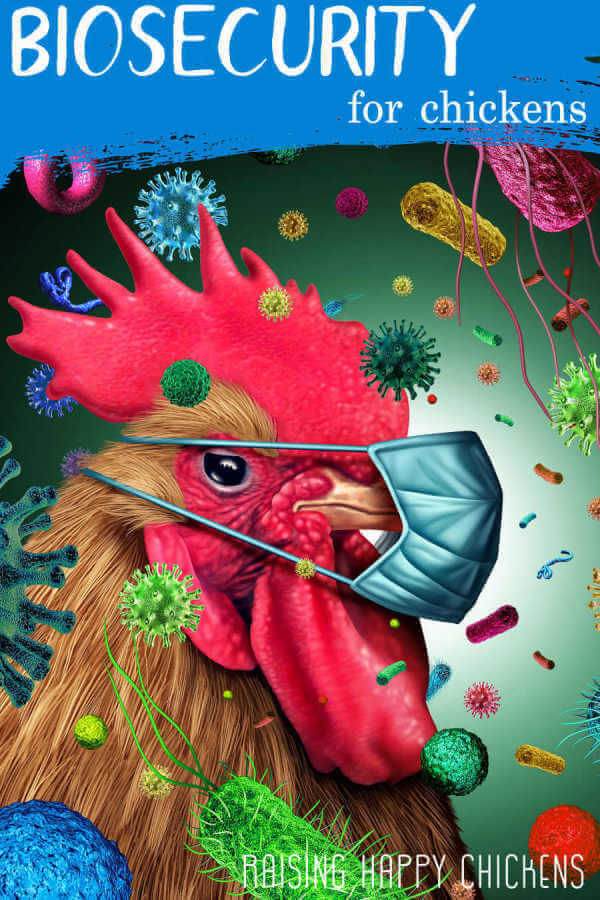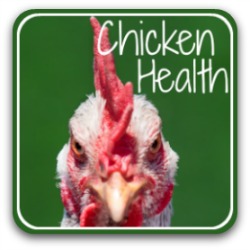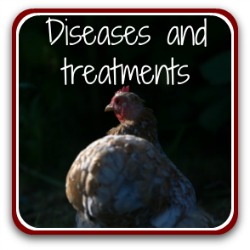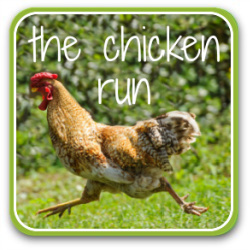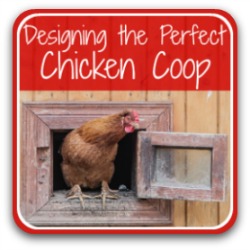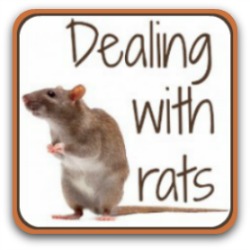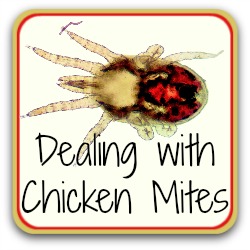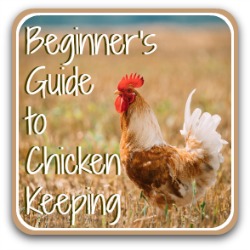Biosecurity: how to keep your chickens safe.
The global spread of disease is a critical current issue. But what does it mean for you and your poultry?
Let's start at the beginning.
What is biosecurity?
It may sound challenging but it's actually very simple.
Biosecurity is putting in place ways of protecting your chickens from disease.
For poultry farms it can become complex and potentially costly. For us as backyard chicken keepers, it's really a case of "informed common sense".
In other words, finding out what's a threat to our chickens' health, and putting in place ways of helping control it.
It doesn't take lots of money. It takes a purposeful mindset and an agreement from everyone involved with your flock that they will take it seriously.
Why is biosecurity for chickens important?
In 2020, we learned from bitter experience how far and how quickly disease can spread. Practicing biosecurity with our chickens is part of the solution to specific diseases which can spread between chicken flocks.
Having biosecurity solutions in place will:
- reduce infection, illness and death in chickens without the need for antibiotics
- reduce the risk of spreading infection between flocks
- increase our own and our family's health by ensuring risk free, safe eggs
- boost our chickens' health
- reduce costs, because of the reduced need for drugs and veterinary intervention.
Put simply, biosecurity is taking steps to make sure we have healthy families, that animals and plants don't get sick, that our flock's health is optimised, and that we prevent conditions which mean disease is more likely to spread.
By adopting what are essentially common-sense processes into our chicken-keeping, we can make sure our flocks and our families are kept as safe as they possibly could be.
What are the main diseases as a result of poor biosecurity in backyard flocks?
One of the main sources of disease for poultry is migrating birds, particularly waterfowl.
Those birds can introduce the particularly virulent diseases like Avian Influenza (bird flu) and Newcastle disease.
 Bird flu - often introduced to backyard flocks by migrating birds.
Bird flu - often introduced to backyard flocks by migrating birds.Although bird flu often starts in its "low pathogenic" form, it can (and often does) develop into "highly pathogenic", where the mortality rate in chicken flocks within 48 hours is 100%.
Other common sources of disease include flying insects such as mosquitoes and flies, animals, in particular rodents, and dirty coops and equipment both on our own property and, importantly, transferred from other people.
The types of disease can be bacterial, like e.coli, salmonella, fowl cholera and Mycoplasma; viral such as Marek's; fungal as in Candiasis and some eye infections; and protozoan, for example Coccidiosis.
We're also talking about a need to control common parasites like mites and worms. And flies can also cause one of the most insidious of all: flystrike.
Does it only affect commercial chicken farms?
No. Many of the reports and studies you'll find are written with large-scale poultry farms in mind. Clearly those which adopt unhygienic practices, apart from damaging the welfare of the chickens, are more risky than the small flocks of the backyard chicken keeper.
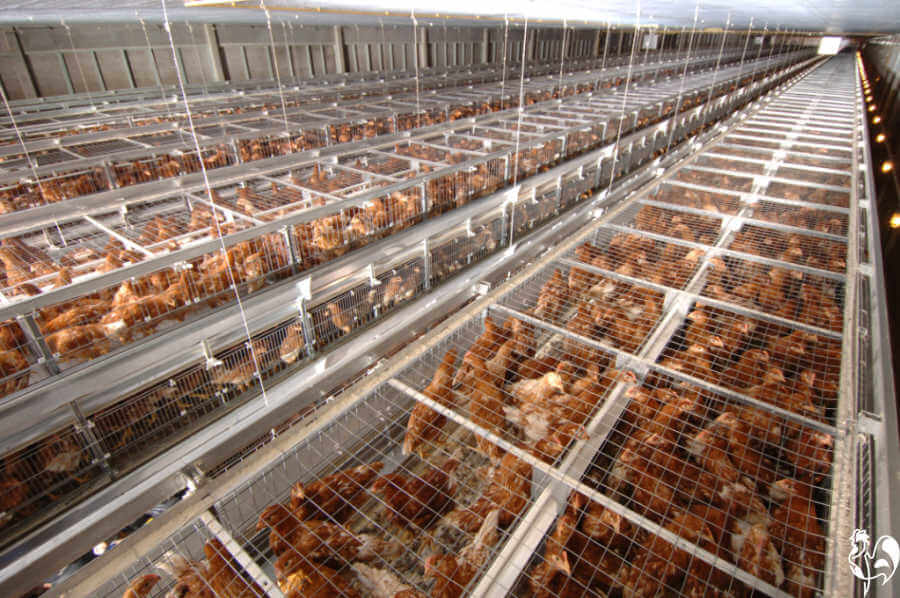 Hens kept in these conditions are far more likely to be susceptible to disease than backyard chickens.
Hens kept in these conditions are far more likely to be susceptible to disease than backyard chickens.The majority of us would genuinely do anything to keep our chickens safe.
But disease can easily be carried into backyard flocks as well as commercial operations. It can also affect school incubating and hatching projects, for example.
The measures we put in place just need to be adapted for a smaller scale, and proportionate to the risks.
As the saying goes, there's no need too take a sledgehammer to crack a nut!
Biosecurity solutions: 8 steps to keeping your own chickens safe.
How to ensure you're practicing good biosecurity measures for your chickens?
If you want a quick answer, it has to be "cleanliness". Which can mean anything from washing your hands before and after handling your chickens, to full-scale cleaning out of your coop and run.
Let's break it down into eight smaller, manageable tasks. It's preferable to read through them all, but if you want information about one in particular, here are links to each section.
Step 1. Top priority: biosecurity and wild birds.
This should be your number 1 priority. Most avian diseases, in particular avian influenza, are transmitted through the air by wind, water and feathers.
Which makes migrating wild birds, particularly waterfowl like swans and geese, a major contributor - but not the only one.
Disease can also be carried by other wild birds. It can be left in droppings, feathers, infected eggs and as droplets in the very air they exhale.
So having that cute wild bird feeder near your coop may be asking for trouble - and not only from birds...
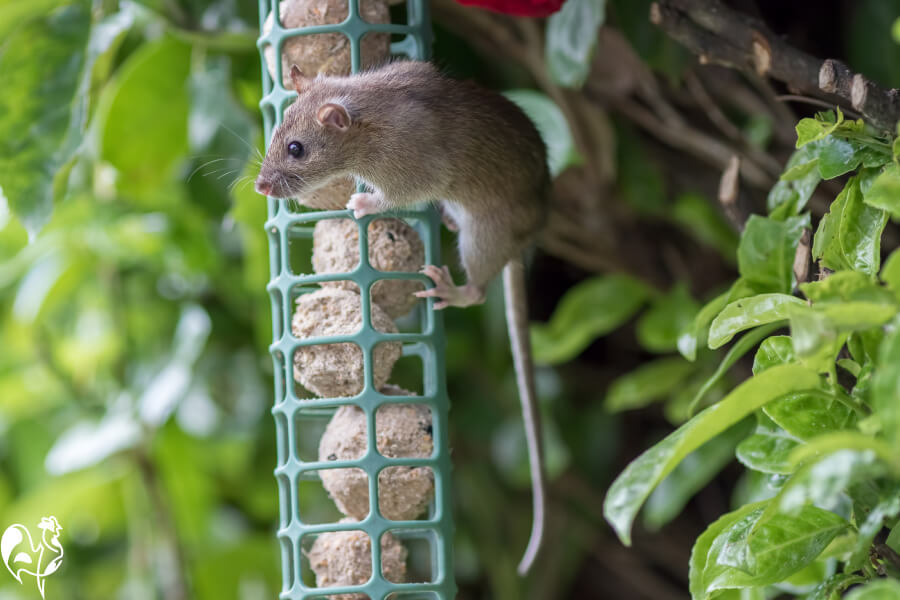 Wild bird feeders can also attract rodents.
Wild bird feeders can also attract rodents.What to do.
- Don't encourage wild birds by having feeders anywhere near your coop. If you must have them, position them as far away as possible.
- Actively discourage birds by not leaving your chicken food or kitchen scraps lying around.
- Don't use open chicken feeders. Invest in an automatic feeder which avoids spillage and keeps feed covered. See my review of one of the best, here.
- Keep your coop and run as closed from wild birds as possible. Use chain linked fencing; cover the tops of your run if it's small enough; keep your coop closed so birds can't nest there; clean away droppings and dead birds immediately.
- Don't have a pond. If you do, make sure your coop is as far away from it as possible. Migrating water fowl gathering is one of the foremost sources of disease.
Step 2. Keep rodents and other animals away.
Rats and mice are known carriers of micro-organisms. The common belief that "where there are chickens, you'll find rats" is not true.
What is true, though, is that where there's grain, you'll find rodents. They have an amazing sense of smell, they can jump three feet from a standing start, they'll gnaw through anything but a good quality metal and they eat 10% of their body weight every day.
And as well as munching their way through your hens' eggs, which they will if they can, they carry such diseases as Salmonellosis and Leptospirosis.
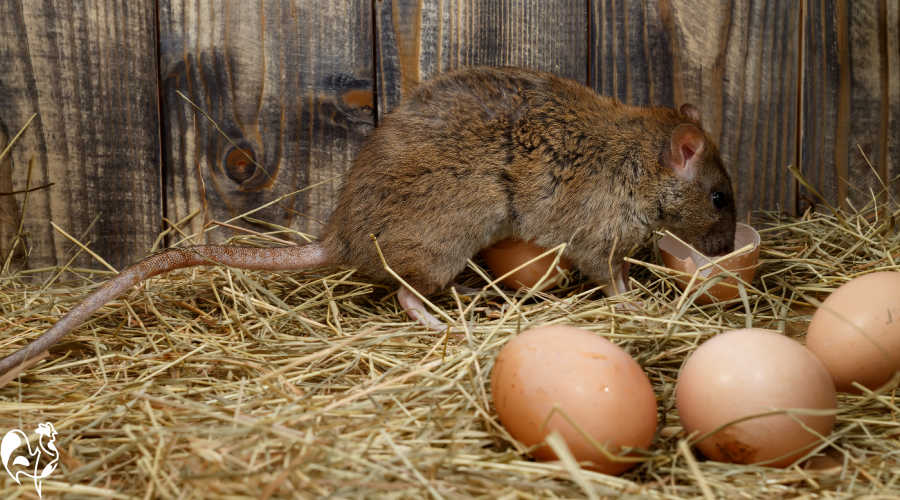
What to do.
- I have an entire section devoted to rats, how to tell you have them, how to get rid of them and how to prevent them taking up residence in the first place. Read it here.
- Again, a good quality, rodent-proof feeder is a must. See my review of the one that keeps rats away from my coop, here.
- Poison is a very last resort for rodent control but it may become necessary if there's an infestation. More about poison, here.
- It's not only rodents which are are potential carriers of disease. Keep dogs and cats away from your chickens - even those you know. You may know and like your neighbour's dog, but you have no idea whether it has been exposed to already infected birds or animals.
Step 3. Introducing new chickens to an existing flock.
Sooner or later, most backyard chicken keepers want more chickens than they thought they would when they started out.
All good - the more chickens, the better!
But whether you get yours from a friend, a reputable breeder, a poultry show, a hatchery or your local feed store, you'll need to take precautions when integrating new chickens into your existing flock.
Why? Because you have no idea whether the new stock has already been exposed to some illness.
What to do.
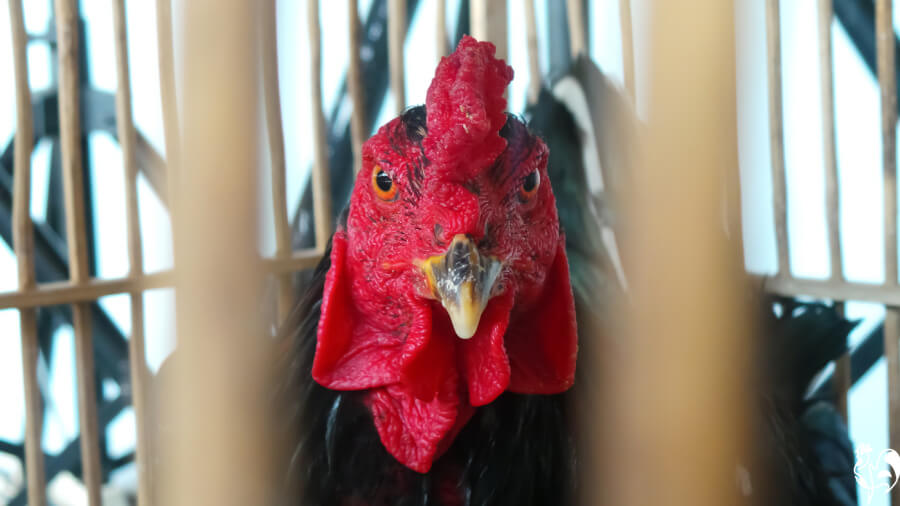 Your new chickens may give you the stink eye, but segregation is critical to controlling disease.
Your new chickens may give you the stink eye, but segregation is critical to controlling disease.- In all cases, no matter where you get the new birds from, they must be isolated from the rest for ten days to two weeks. That gives time for any illness to show up. There's more detail about how to do that in this article.
- Different breeds and ages have different immune responses. What one breed may be immune to can be deadly to another. So studies(e.g.1, 2, 3) indicate it is preferable not to mix them.
- Don't keep different species together, for example ducks and chickens. Their needs differ, and ducks need water. Having a pond is a sure-fire way of attracting migrating water fowl. And waterfowl are known spreaders of diseases like Avian Flu.
- If you have chicks, always deal with them first before taking care of your older chickens. Chicks' immune responses have not yet built up, so you need to reduce the likelihood of transmitting any organisms from your adults.
Step 4. Keep your coop and runs clean.
This should go without saying. Disease spreads much more easily and quickly where hygiene and cleanliness are poor.
Chickens are not cats. They don't clean up after themselves. So you have to take responsibility and do it for them.
Always bear in mind that micro-organisms can survive for weeks and some, such as Coccidiosis, for months. Flies will be attracted to dirty bedding and can carry more than 600 pathogens harmful to poultry(4).
How to keep these tasks under control.
Joining my newsletter means you'll receive a monthly reminder of 20 tasks to be completed before the month end, together with a free printable checklist reminder. Which means you'll always have biosecurity measures under control.
Take a look at this page for more information about what you'll get and how to sign up.
What to do.
- Get into the habit of cleaning the coop and run regularly. Clear droppings from bedding every day, and clean out the bedding itself (or make sure it's turned if using the deep litter method) long before it gets wet. If you can smell ammonia, it's way past time.
- Deep clean your coop at least twice a year (unless using deep litter). Clear out bedding, wash down with a detergent, allow it to dry and then re-wash with a strong disinfectant. Rinse, and allow to air dry before the chickens go back in.
- Add dust baths to your coop and run so your chickens are able to keep themselves clean and free from pests like mites. More about dust baths, here.
- Make sure your coop is properly ventilated. Clean air circulating is essential. Find out more about this, here.
- Keep undergrowth around the coop and run cut back. Thick grass, weeds and rubbish left lying around is an ideal habitat for rodents.
Step 5. Keep food and water disease free.
Food and water can both be an important source of contamination. The quality of drinking water in particular is critical: dirty water potentially hosts both bacteria and fungal slime.
Yes, I know chickens drink from puddles when they get the chance. But it's the cleanliness of the water carriers that's the important task here.
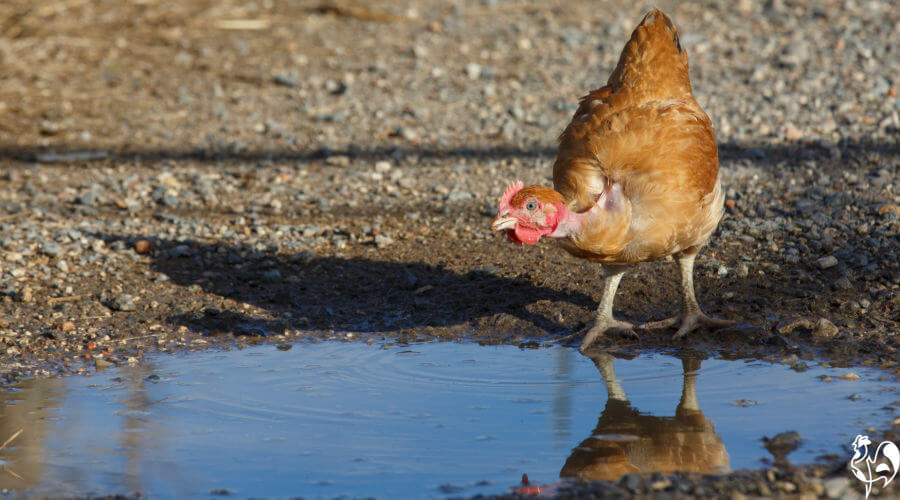 Chickens drinking from puddles is fine. It's waterers that need to be kept clean.
Chickens drinking from puddles is fine. It's waterers that need to be kept clean.What to do.
- Keep all feeders and waterers clean. Automatic waterers in particular should be regularly flushed out, particularly if they involve pipes. Clear out all grain and old water, flush through with clean water and a good quality disinfectant. Rinse thoroughly and leave to air dry.
- Use good quality feed from a reliable source. Don't ever share feed, or use old feed - you don't know whether it's been contaminated by rat faeces or urine.
- Clear up any spilled feed, and throw it away. Again, you don't know whether it's been contaminated by rats or wild birds.
- Never leave rotting food about. It's a sure way of attracting both rodents and wild birds. If you feed treats, give only what will be eaten that day.
- I'm going to mention that automatic feeder again - it prevents grain spills and prevents rodents and birds from leaving their unwanted calling cards.
Step 6. Limit visitors and visits.
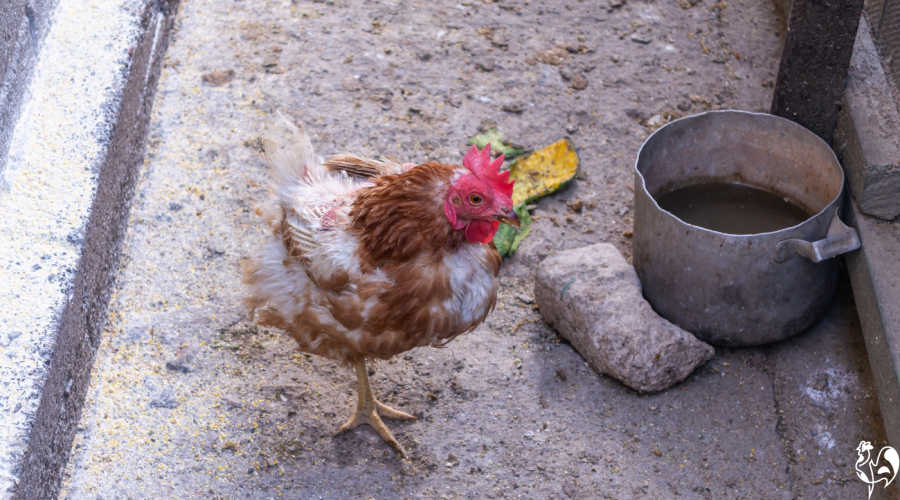 Keeping chickens in conditions like this will allow disease to take hold.
Keeping chickens in conditions like this will allow disease to take hold.All research studies about the transmission of disease agree that one of the most serious threats to biosecurity is people.
Disease-causing viruses and bacteria have been found on human clothing, shoes, skin and hair(5).
Farm equipment too - tractors, lorries, trucks and any vehicles or crates used to transport birds - are also potential carriers.
So whether it's family members, friends and neighbours, service and delivery personnel or paying guests, movement in and out of your chicken coop and run, or homestead if you have one, should be seriously restricted.
What to do.
- Restrict unnecessary visitors. If you have parties, don't allow guests to wander into the chicken run - apart from the biosecurity risk, alcohol and live animals tend not to go well together.
- If family members visit regularly, keep footwear which is used only for going into the run. I keep a pair of pink wellington boots handy - my chickens love seeing them because they know it's likely to mean treats!
- Large poultry productions often have shoe washing trays at the entrance to their premises. This is not strictly necessary with small backyard flocks - unless you already have disease on your land, or if it's known to be in a flock close by you.
- Don't visit other farms unless there's a specific reason for going. If you have no option, make sure you adopt good hygiene practices by using specific shoes or boots and some form of clothes covering.
- And whoever visits, make sure they and you practice basic hygiene by keeping hands washed.
Step 7. General awareness: check your flock regularly.
It's often hard to tell when chickens are unwell. They hide illness because it's potentially fatal to allow predators to see they're weak.
So it's important to be aware of possible signs of disease. Early detection can help reduce the impact and spread of disease both within your own flock. And it reduces the likelihood of cross-spreading to others.
What to do.
Watch for signs of disease in your flock by checking your flock every day, simply as you go about your business in the coop and run.
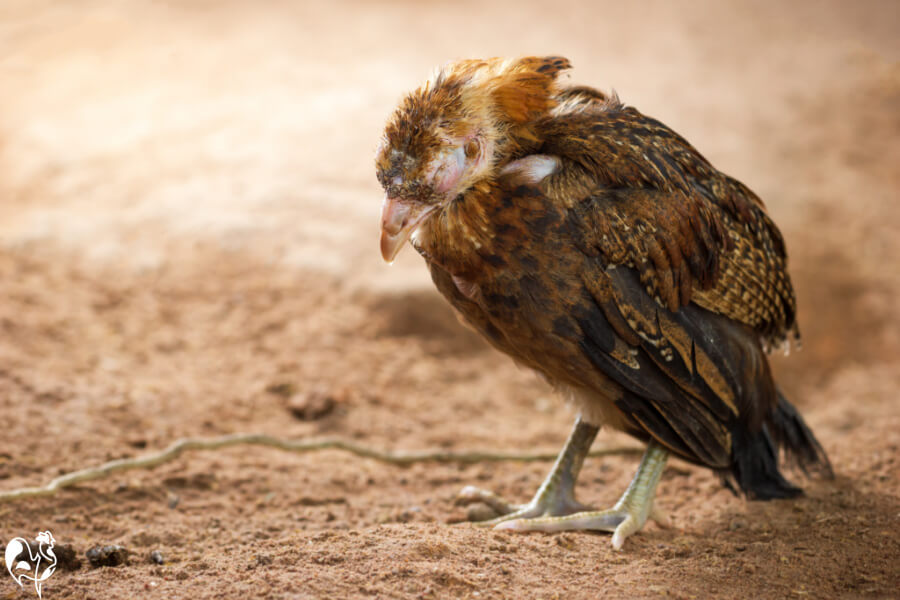 Sick chickens will look listless, hunched and often swollen.
Sick chickens will look listless, hunched and often swollen.Clinical signs associated with the possibility of disease in a poultry flock are:
- Loss of energy and appetite
- Fewer or no eggs, or soft-shelled, misshapen eggs
- Swollen or discoloured head, eyes, combs, wattles and legs
- Discharge from the nose
- Coughing, wheezing or sneezing
- Sudden loss of co-ordination, or unable to stand
- Diarrhea.
Step 8. Prevention - better than cure.
Good nutrition goes a long way to helping prevent disease taking hold. It's an essential part of your biosecurity strategy.
It's always much more beneficial for you and for your chickens to prevent disease than to rely on treatment. And healthy, unstressed birds have a more effective immune system to protect against disease.
What to do.
- Feed your flock with a good quality, nutritionally balanced chicken feed appropriate to their age.
- Be aware of natural, healthy treats which add vitamins and minerals to your chickens' diet without adding too much protein or fat. Particularly look for natural additions to the diet: there are some weeds and common plants which are amazing immune-boosters.
- Watch this short video for more detail.
- Keep your chickens as stress-free as possible by protecting them from predators.
- Make sure your flock has their five welfare needs met so that they can display natural behaviours: in particular the ability to dustbathe; to have space to forage, if not free range then within a secure run; to have a safe place to nest and lay eggs.
Conclusion: "informed common sense".
It may seem like there are a lot of things to remember about biosecurity, and it should certainly be considered, planned and implemented.
Because detecting disease early and managing its spread is, as we have all discovered, critical to our own health and safety as well as that of our chickens, pets and other livestock.
At the end of the day, though, it's not difficult. It's all about keeping your chickens and their surroundings clean, safe and as free from the stresses of chicken life as you can make it.
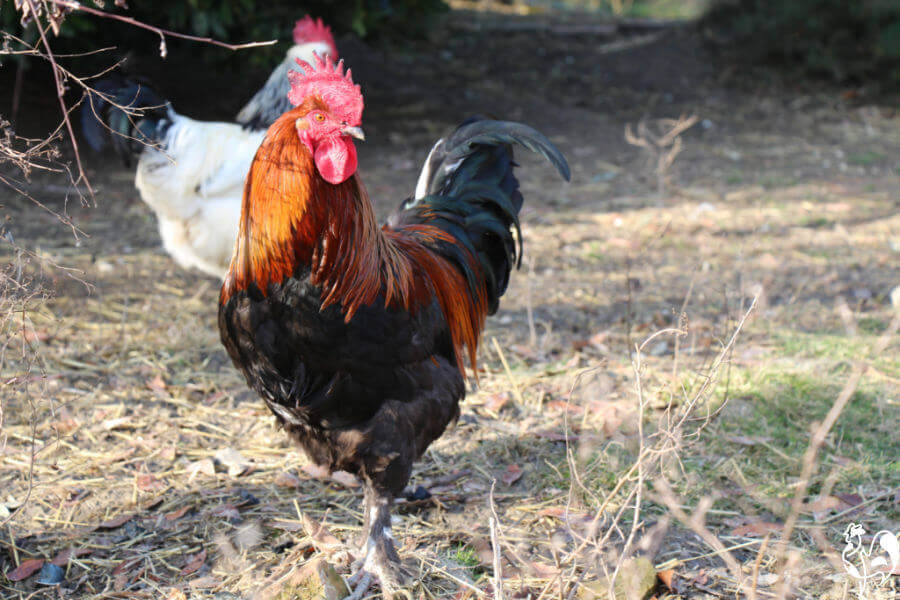 What you're aiming for: healthy, safe, stress-free chickens like my Black Copper Marans rooster, Julius Caesar.
What you're aiming for: healthy, safe, stress-free chickens like my Black Copper Marans rooster, Julius Caesar.You may find these pages useful to keep your chickens safe.
Sources and further reading.
A lot of "facts" you'll find on the internet are often people's individual views, based on inaccurate information repeated from poor quality sources.
The information I provide in this article and others is based not just on my own experience, but on evidenced facts from scientific, peer-reviewed research and books from highly respected and experienced poultry keepers such as Gail Damerow.
Some of the trusted sources I have used in this article are these.
1. National Farmers' Union, UK: Avian Influenza webinar. Aired October 2020.
2. Biosecurity and Disease Prevention. Pub. The Poultry Cooperative Research Centre, 2019.
3. deGraft Hanson, Dr J: Biosecurity for Backyard Flocks. Pub. West Virginia University, 2002.
4. US Department of Agriculture: Flies and Salmonella - a Bad Combo in Poultry Houses. Pub. Science Daily, 2008.
5. US Department of Agriculture: Biosecurity: Defend the Flock. Pub. 2020.
6. Fairchild, Professor B, and Cunningham, D: Biosecurity Basics for Poultry Growers. Pub. University of Georgia, Department of Poultry Science, 2006; reviewed and updated 2020.
7. Khalid, Dr M: Biosecurity measures for poultry farms. Pub. University of Lahore, Department of Veterinary Sciences, 2017.
8. McElroy, Dr A: Biosecurity for Poultry. Pub. University of Texas, Department of Poultry Science, 2014.
